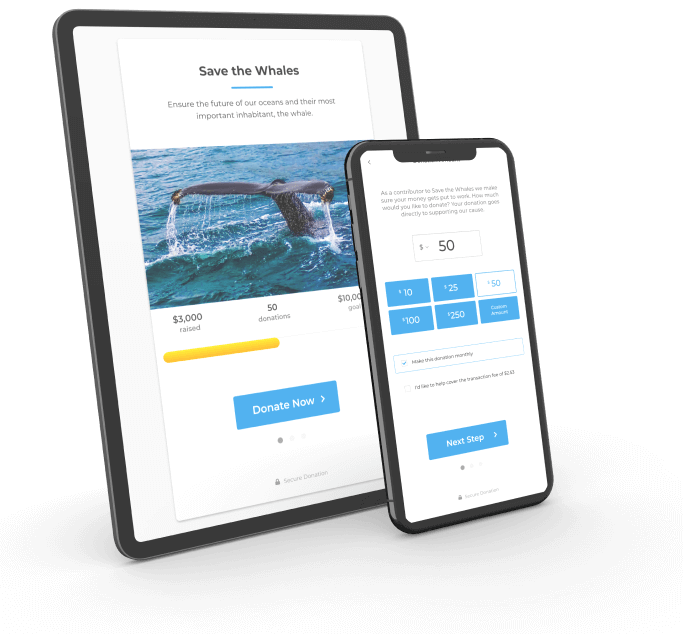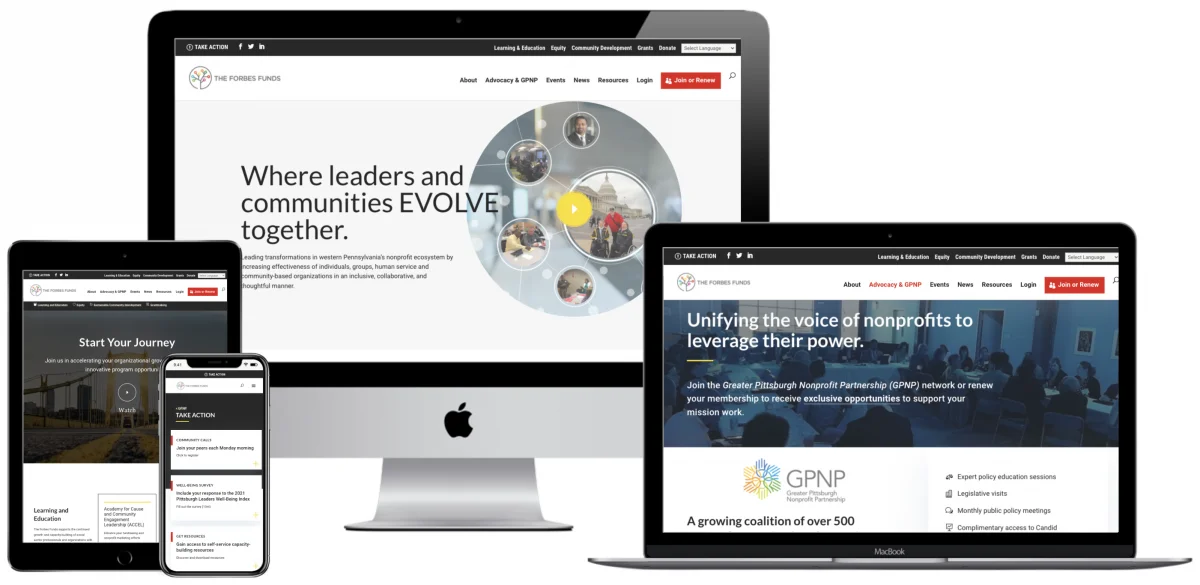Most people get into the nonprofit/charity world to make a difference in the lives of those less fortunate or to rally for a cause. Either way, those who work for nonprofits are passionate about what they do and they want to help people. Often, the only way to help people is by securing funding. Some funding comes from grants, government initiatives, private donors, and local businesses and other nonprofits are highly reliant on individual giving.
Politics aside, judging from the political campaign of Bernie Sanders, it shows how far a few dollars can stretch. Sanders was able to raise $7m in a single day, mostly comprising of donations that averaged $34. So, with enough people behind your cause, even a donation of $5 from many people can have a lasting impact.
If you don’t have a solid donation page set up (i.e. you aren’t gaining the traction you’d like or seeing the funds you need) or, on the other hand, if you want to boost engagement by creating a new donation page, here are the best practices for donation pages for 2020 and beyond.
The bottom line is that funds are what can make the difference between impacting a few or impacting en masse.
Step 1: create a donation page/landing page
The donation page is a page where you direct someone to after you’ve asked them to donate to your organization.
In the marketing world, this page is called a ‘landing page’ because your potential customer (in this case, donor) ‘lands’ on the page and you’re asking for an exchange of some sort. In marketing, you may want to gather their name and email (valuable information for you) in exchange for downloading something such as an eBook you’ve written, which is valuable to the recipient (hopefully).
In the charity world, you’re asking for a lot more information. You’re asking for their full details and their credit or debit card number (or PayPal, etc).
People feel good when they donate to charity (because our brains are hardwired to think that way), which is good news for you.
SEE ALSO: Towards Goodness and a Future of Humanness
But, how do you get people to donate, so they can feel good about themselves? Well, you tell them the benefits of donating to your campaign–benefits not only to your cause but also of them personally. So, before creating your donation page, you want to decide the benefits to the person donating and, of course, precisely nail down exactly what that funding will do for your cause. People do not like wishy-washy language or to think they are donating to this great cause, but only, say, twenty cents on the dollar will actually go to that cause.
Besides outlining the benefits of donating, successful donation pages have six main things in common.
- Clear mission. Successful pages disclose the organization’s mission. Why do you exist? Why should they give to your organization? What are you going to do with the money? How will it be allocated? What difference will it make? What the organization does and why is the most important factor to donors.
- Clear branding. Next, donors want to see your organization’s branding. Just like recognizable businesses have a well-designed logo and colour palette, your organization should too. Donation pages with clear branding receive 700% more donations because they are deemed more trustworthy. Make your branding and your message clear.
- Clear storyline. People love a good story. Great donation pages often share a story of a specific person–including an interesting photograph of that person–that your organization helped. Seeing a face with a story helps people identify with the story versus an image of a group of people and (bonus) a good story is proven to encourage donor generosity. For example, if your organization helps rough sleepers find jobs, having a picture of a well-dressed, formerly rough sleeper who has now begun the path to a successful career accompanied by a personal story will connect with readers more readily than a picture of twenty people without that personal human element.
- Clear endpoint. Those who give like to know exactly where their money goes. It’s important to provide a breakdown of exactly where the money goes and why. Most people understand there will be staffing overheads, but it’s important to be clear and honest about where the donations go and how their dollar stretches to impact the community. This detail is the second most important detail for donors when deciding where to spend their money.
- Clear figurehead. Abby Jarvis from Qgiv shares a top tip that a personal message from your organization’s president or a member of the board goes a long way to helping create further connections with the cause. Why is this organization so important to those who head it? How do they connect with it and why should you?
- Clear goal. When asking for donations, it’s a good idea to ask for a specific donation amount in the copy. When asked why people donate in The Science of Generosity, people simply said they were asked. Also, when writing a statement asking for a donation, do not give an abstract value such as ‘donate $15 to end world hunger.’ That sentence makes people feel like they cannot possibly make a difference (and will encourage people not to donate). But if you posit something more achievable such as, ‘donate $15 today. Your $15 can pay for part of a $375 LifeStraw that will enable safe drinking water for an entire school in western Kenya for 3-5 years.’ Having a specific figure in mind can help people connect to the cause and see that their hard-earned money can and will make a difference to you, no matter how small or large the donation.
Step 2: consider page structure, keywords, and mobile design
Now for the less fun part. You’ve carefully crafted your message, written your personal stories, had messages from the president and the board, branded your page, nailed your mission, and created specific statements of donation intent. But now you need to consider some of the following on-page SEO elements.
- Target keywords. Your donation web page needs to be found by Google in just the same way your regular web page is found by Google, which means it needs all the same technical bits. You need to include target keywords (long tail and short tail) in your landing page copy, thank you page copy, website copy, social media copy, in your meta tags and meta descriptions and so forth. You want to include words specific to your charity and your mission. But also consider queries your potential donors will type into Google and speak into a voice assistant.
- Links. Put your links everywhere! Add links to your donation pages on social media, in your email marketing, in your newsletters, on your blogs–anywhere you might be found. Ask newspapers to write about you and include links. Ask for guest posts and news coverage online. Make videos and add links in the description boxes. People need to be able to find you and they should land directly on your donation page.
- Submission/donation form layout. Consider how you will lay out your content and what you’ll include in the form. Do you want to include the person’s name at the top of the form? If you ask for the ‘easiest’ fields first, it psychologically tricks donors into thinking it’s ‘simple.’ A form with something quick like name, email, amount, and PayPal details (or credit card info) will seem much less daunting than a form that has several pages and asks for many more details like address and phone number. Consider if you want a pop-up donation box or if you want to create CTA buttons along your page as readers scroll through the content. Think about performing A/B tests to see which patterns work best for your donors.
- Mobile first donation page. Just like in good web design, you want your donation pages to be mobile-friendly and very easy. If donors have trouble entering their card details, scrolling, or the general experience is glitchy you’ll see high bounce rate, but if the experience is incredibly easy and the buttons and type fields are easy to use, you’ll fare much better. Since over 60% of people browse on a phone or tablet before using a laptop or desktop, if your mobile form isn’t your top priority, you may be losing out.
Step 3: craft a story that inspires people to donate
This point was briefly mentioned before, but we cannot stress enough the power of storytelling. Your fundraiser story should be adequately detailed and compelling enough for people to want to support your cause. Take the time to craft a meaningful and touching message that should span more than 400 words.
Think of the who, what, when, why, and how. Consider the following questions.
- Who is the recipient of your funds? Who gets the money and why? Why does this person, family, organization, cause deserve someone else’s money? If the fundraising is personal (i.e. you’re raising money for your family because you or a loved one has cancer, for example) then explain just how much of an impact these funds will have on your life (or the lives of those you love). Be open and honest.
- What is the conflict/obstacle in the situation? In the LifeStraw example, waterborne illness can infect hundreds, clean drinking water can save lives. The obstacle in the scenario is unsafe and unclean water. The solution is finding a way to create potent, safe drinking water. For your organization, what challenges are the people, organizations, individuals, animals, whoever facing? And why is it worth finding a solution?
- When do you need the funds/what is the timeframe? Tell your potential donors when the money is needed to foster a sense of urgency. Of course, some projects are ongoing and can make a difference at any point and other causes have a definite endpoint (such as in the case of illness or a field trip for an entire class of 5th graders).
- Why is their help necessary? It’s important to tell people how and why their donations are crucial to your efforts.
- How specifically can donors help your cause? You can list expenses that your organization needs help paying to help people understand the impact of their donation; however, some people argue that giving figures too large makes their donation feel like a drop of blue paint in a vat of yellow paint (i.e. the paint won’t turn green). The how is up to you. You can give the overall, overarching picture (like you’ve raised $10,000 towards your $100,000 goal) or some ways that it makes giving seem more achievable (you’ve donated $10 that helps towards our $1,000 goal of donating 100 books to a 10th-grade classroom in an underprivileged area).
If you want more details, in our piece ‘Incorporating Storytelling into Nonprofit Web Design,’ we explain further how to find and craft the right story for your organization.
Step 4: create visual elements such as photos and videos
Great visuals capture everyone’s attention, which goes to everything from overall design to photos, videos, CTA button placement, transitions between pages and so forth. You want to create a visually exciting page; however, you do not want to overwhelm from the purpose. A good designer knows that white space is just as important as text and visuals.
Step 5: use your donor platform to design a donation form
A good way of collecting repeat donors is to link your donation form to your contact database. That way you can make donation part of your email campaign (but careful not to hound your potential donors). You can encourage people to make small monthly donations — or whatever your strategy — so you can focus on new prospects.
Don’t have a simple donation form or robust donor management platform implemented yet? We highly recommend GiveWP, which integrates directly with WordPress’ content management system, and so many other integrations

But, when designing your donation form, be sure to consider the elements carefully (as discussed in step two). Think about what information you need and how to make it easiest for the person donating.
You may want to collect the donor’s full name and email address, but consider if phone number and mailing address are important for first-time donors.
It’s also a good idea to include a CAPTCHA on the form (use a simple checkbox on mobile) so that your nonprofit does not get targeted by those trying to test credit card numbers. Another way of bypassing this need altogether is linking to a hosted page like PayPal.
If you are given consent to contact the donor again, you can always get in touch at a later date and ask for a further donation, but understand your audience. You don’t want to turn the relationship sour; you want to keep people motivated and excited about your cause and not make them feel like you’re a nuisance caller or spam clogging up their inbox.
Step 6: send out automated receipts, tax receipts, and thank you messages
A simple rule for creating donation pages is to say thank you. Everyone likes to be thanked for contributing to a cause. You can make this step easy. Once a recipient donates, it can send them to a thank you page that reiterates your message briefly and thanks them for their specific donation–and how they are really helping their cause. You may also want to automate sending a receipt and/or tax receipt to their email with a further marketing email that points your donors to more resources or ways to keep up with the cause.
Step 7: make your donation page shareable
People love to share the causes they care about. They want to show their friends they donated and allow their friends to donate, so your thank you page can have a shareable social media (and email) link that allows people to send out a templated message saying something along the lines of ‘I donated to [such and such] cause and you should too. Here’s why’ (or whatever message you choose).
Making your page shareable means more people can hear about your cause and donate. If you create a fun infographic, video, or inspiring text, you may increase the likelihood of shares (and the likelihood of going viral).
Step 8: add a donate button to your website (CTA)
Again, whenever people are scrolling down your page, you want to give them plenty of reminders to donate. You want your CTA to be a big ‘welcome’ sign and make it very clear what the next step is. You want it to shout, Hey! Click here. Click here. Donate now. You believe in this cause.
Putting a donate now CTA on every page of your site and especially your landing page will make it easy for people to click. If they have to search to find where to donate, they are likely to give up. It’s a good idea to create a CTA button in your top menu.
Step 9: drive traffic to your donation page
In marketing, you may spend 20% of time creating content and the remaining 80% of time promoting it. What’s the point in having awesome content if no one sees it. Find ways to promote your page to increase views.
You may simply share it on all your social channels or choose to engage in a paid ad campaign, ask for backlinks, news coverage, and whatever else, but you need to promote the cause in as many ways as possible.
Step 10: how Key Medium can help
Despite being a for-profit business, we here at Key Medium feel it is important to have a positive impact on the local community, to give back more, which is why we help nonprofit organizations create beautiful websites at a competitive price. We also offer our affordable SEO services to help boost search so that these nonprofits can do more by getting more.
We also personally support four initiatives close to our hearts, through our Coding for Causes Program:
- Grounded in Philly, part of the Garden Justice Legal Initiative
- The Forbes Funds
- Philly Food Finder
- North10, Philadelphia
Take a look at our case studies to see how we give back even beyond those two charities we support directly.
Need us to help you create your donation page or website?
We are here to help. Whatever you need, we want to hear about your cause and help you reach your donation goals. From setting up a donor management system like Give using WordPress or CiviCRM — to creating a human-centered experience online, get in touch.

Elaine Frieman holds a Master’s Degree and is a UK-based professional editor, educational writer, and former marketing agency content writer where she wrote articles for disparate clients using SEO best practice. She enjoys reading, writing, walking in the countryside, traveling, spending time with other people’s cats, and going for afternoon tea.

